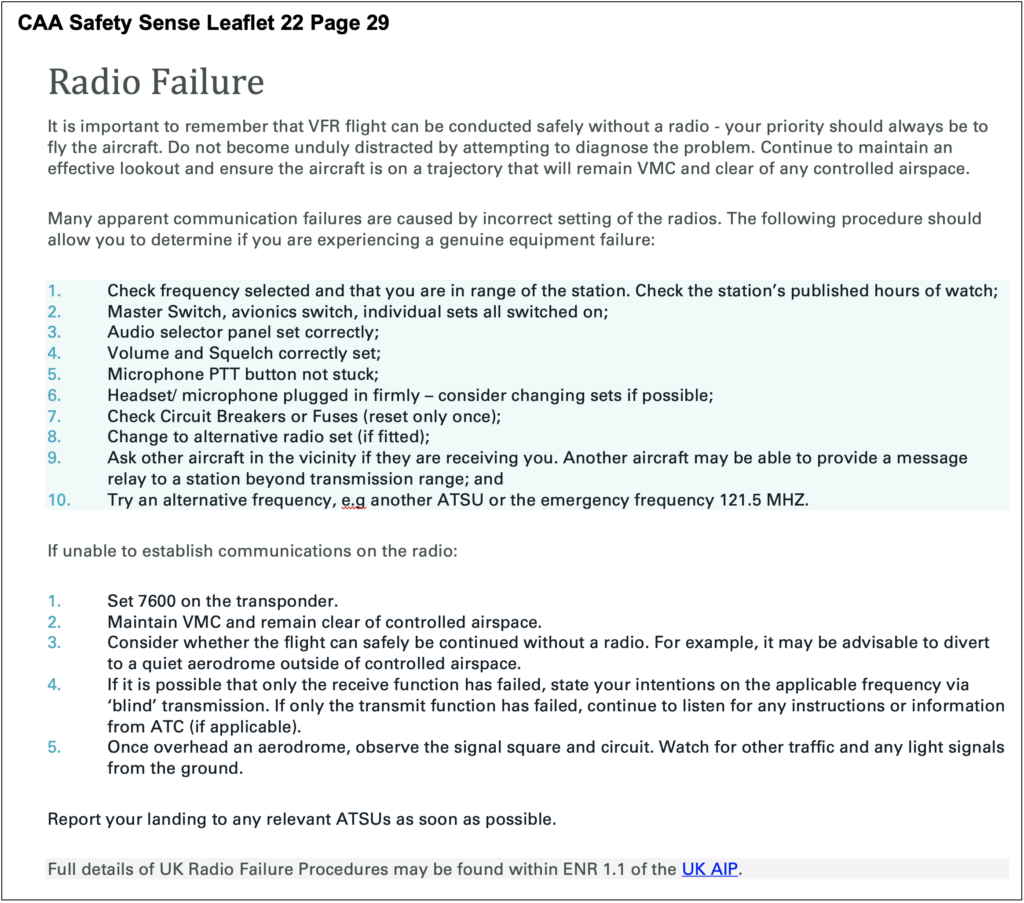The Charity
Aviation
Maritime
GA1336
Initial Report
In the cruise under a Traffic Service outside controlled airspace I was approaching the lower edge of the Yorkshire CTA at F100 and I attempted to call ATC to inform them of my position in relation to the airspace. However when I keyed the mike, the radio was overwhelmed with a very loud “squelch” sound which completely drowned out my transmission and meant I could not hear anything from ATC. My first action was to see if this was an external interference but neither of my radios were showing a RX indication. So my next action was to try to cycle the squelch button on the Comm1 radio I was using. This had no effect. So I then tried to switch to Comm2 radio but the situation persisted. I then tried to recycle both Comm radios by turning them off and on again. This again had no effect. So I was about to cycle the transponder to 7600 when I thought to try the ground clearance radio. When I switched on the ground clearance radio the noise vanished and I was able to use Comm1 without any problem but the Comm2 radio was now isolated. I called ATC to inform them of the situation and was informed that they had been trying to call me. They asked me to turn onto 090º which I did. After this I tried turning the ground clearance radio off after 5mins and the problem did not reoccur so I continued to [Airfield]. On the ground at [Airfield] all the radios seemed to be working ok but on doing a system check I got a message “Comm2 requires service”. On an earlier flight I had a problem with the stall-warner heater which on one occasion caused the circuit breakers to pop so I had already decided to have a full electrical check done.
Subsequent information from reporter: I usually use my Comm1 radio for the ongoing communications and use the Comm2 for ATIS frequencies and for ground radio at airports. The Comm2 radio was configured for 8.33KHz the same as my main radio. The issue was with the Comm1 radio. After the incident, and after I had submitted the CHIRP report, I took the aircraft to the engineers to have the radios checked. The issue occurred once again on the way down to the engineers but had again cleared up by the time I arrived. The engineers found that the Comm1 radio was very slightly loose in its mounting cradle and that when vibrated, the connectors at the back came partly unplugged and there was a poor connection/shorting which caused the interference problem. They noticed that pulling and pushing the radio caused it to move forwards and backwards by about 1mm and, when pulled outwards and to the side, the interference manifested itself. They tightened the mounting screw on the unit which made it tight into the sockets and this resolved the problem.
They surmised that some turbulence may have made the radio move in its mount affecting the connector at the back, and this was why the problem came and went. Since they tightened the mounting screw, the problem has not reoccurred.
CHIRP Comment
Notwithstanding the mechanical nature of the problem that was eventually traced by the engineers, the possibility of communications failure in flight is something for which we should all be prepared and bears thinking about before we take to the air. Communications problems can manifest themselves from a number of sources including mis-selection of frequencies or modes etc on the pilot’s part, mechanical problems as in this case, or even harmonics between the aircraft’s radios that only manifest themselves at particular frequencies selected (this sometimes occurs, and can be resolved by selecting the out-of-use radio to off). The key thing though is to have a systematic plan for working through the likely issues to try to resolve the problem. In doing so though, don’t forget the maxim ‘Aviate, Navigate, Communicate’ – resolving communication issues should come third in your list of priorities. Consider the use of the 7600 squawk to highlight to ATC that you have a problem, turn promptly away from controlled airspace if relevant and possible so as to avoid an infringement, and make sure you know what you will do if you have to join ‘radio failure’ at your destination airfield.
With regard to diagnosing communication failures, CAA Safety Sense Leaflet 22 (SS22) Page 29 (see below) offers useful advice. In reviewing this advice we note that it doesn’t mention the potential for mis-selection of the radio mode for 8.33/25kHz dual-mode capable radios. We’ve highlighted this to the CAA and suggested that Item 4 in the first list (Volume and Squelch correctly set) could usefully include a prompt to check the mode selector on radios that have a dual 8.33kHz/25kHz capability to make sure it is set correctly.

Key Issues relating to this report
Dirty Dozen Human Factors
The following ‘Dirty Dozen’ Human Factors elements were a key part of the CHIRP discussions about this report and are intended to provide food for thought when considering aspects that might be pertinent in similar circumstances.
Distraction – potential for becoming distracted by loss of communications
Awareness – loss of inputs from other agencies
Knowledge – potentially not being aware of ‘radio failure’ procedures
Communication – inability to communicate with others
This data type is not supported! Please contact the author for help.